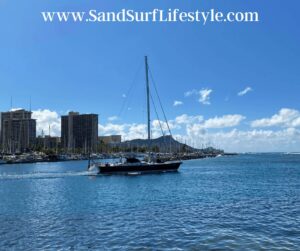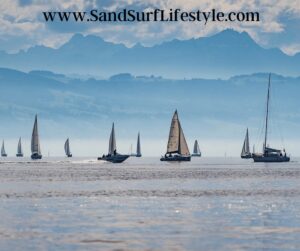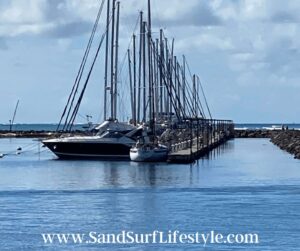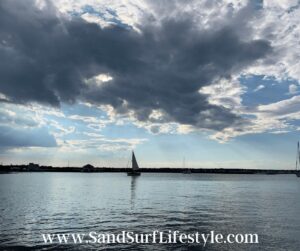With the sun shining and the waters getting warmer, it’s no question that people are taking to our oceans and lakes. When you’re sailing, though, it’s important to know the different parts of your sailboat and what they do—including the keel.
But all sailboats are different, especially when it comes down to their keels.
What are the different types of keels on a sailboat?
The different types of sailboat keels include bilge, bulb, canting, centerboard, daggerboard, fin, full, lifting, leeboard, and wing keels.
 Before you read on, it’s important to know some terminology.
Before you read on, it’s important to know some terminology.
A keel is a weighted, vertical, flat blade that runs down from the hull of a sailboat. It acts as a ballast, keeping the boat from tipping over or heeling in the water. Because it is under the waterline, it stops slipping leeward, or sideways, because it creates a track and counters the sideways force of the winds that hit the sails. Without some sort of keel and some sort of ballast, the sailboat is in danger of capsizing.
The keel varies in shape and size, as you’ll find out as you read more, but it usually looks like some sort of fin. The keel’s makeup is also dependent on the rest of the boat—a metal boat will have a metal keel, for example.
The only time a boat does not need a keel is if they are double-hulled, like a catamaran. Otherwise, a keel is absolutely necessary to make sure your boat stays upright.
Interestingly enough, throughout boatbuilding history, laying the keel is the most important part of the building process. In both British and American tradition, laying the keel is considered the “birthday” of the ship.
Other Terms
Aft is the rear of the boat.
Draft is the vertical distance that a boat penetrates the water.
A foil is when an object is placed within moving fluid at a particular angle so lift is larger than drag. A keel is an underwater foil that is used as a counterweight to the boat’s sails, using forward motion to counteract the wind trying to push the boat side to side.
Heeling is when the boat tips from one side to the other, usually because of the wind on the sails or extra weight in the boat.
The hull is the structural body of the boat that rests in the water.
Leeward or leeway is when the boat slips sideways while moving forward downwind; it is the side of the boat furthest from the wind. When a boat heels, this is the lower side.
Port is the left side of the boat.
Starboard is the right side of the boat.
Wetted surface means the amount of water that the keel is in contact with. The larger the wetted surface, the less slippage to leeward and less heeling that occurs.
Windward is the side of the boat that is closest to the wind; if your sailboat heels, it is the higher side.
Different Types of Keels
There are two different types—fixed and moveable keels. Fixed heels include the bilge keel, bulb keel, fin keel, full keel, and wing keel. These types of keels are either part of the boat’s hull or bolted on.
Movable keels are the canting keel, centerboard, daggerboard, and leeboard. These can be lifted out of the water, making the draft for your boat more shallow and allowing you to enter different, more shallow waters.
Bilge Keels

Bilge keels are either double fin or double full keels, and due to their size, they allow the boat to be beached. Because they have double the surface area, similarly to the full-length keel, they are comfortable and decrease heel.
The downside of a bilge keel is that they are not as effective in reducing slippage, causing your sailboat to list side to side in heavy winds. Central keels help reduce slippage more than the bilge keel.
These types allow the boat to be used in tidal waters as they can be beached, adding to their maneuverability, but they are still not as maneuverable as the fin keel. They can also be stored resting on their keels—this makes storage and maintenance that much easier.
Bulb Keels
A bulb keel is a variant on the fin keel; they are made more stable by adding another ballast in the tip of the keel. Typically a bulb or teardrop shape, this ballast helps also to lessen the need for a deeper fin, increasing the comfort of your sailboat.
Compared to the fin keel, their usage is different. The bulb keel is more frequently used in shallow waters where there are more natural hazards, as it bounces off rocks and coral and is less likely to break. They are also much slower than the fin keel.
Do you know what to do if your boat is leaking through the transom? Find out here.
Canting Keel
A canting keel uses a canting hinge at the bottom of the boat, allowing sailors to move the keel windward and counter the force on the sails. Similar to the hinged centerboard keel, it also works on a hinge, but instead of end to end, it hinges side to side.
Due to the ability to reduce the wetted surface of the keel, it increases maneuverability. These are usually used on high-performance sailing boats and are harder to maintain due to their moving parts.
Centerboard Keels
A centerboard keel is like both the fin keel and the lifting keel, but it can pivot, so your sailboat can sail inland and coastal waters. Because it works on a small hinge, if your sailboat bumps into a hazard, the hinge can push the keel back into the boat, moving it out of the way.
Typically used on small fishing boats, the hinged, retractable keel allows sailors to increase or decrease draft. Both centerboards and daggerboards are used on high-performance sailing boats, like catamarans and trimarans.
Daggerboard Keels

A daggerboard keel also lifts similarly to the centerboard keel, but it lowers straight down from a casing. Because of its shape, the daggerboard turns forward motion into lift, which means it helps to counteract the sideways push of the wind in the sails.
They typically do not have a ballast and are used by small boats like single-person sailboats. They are also easily removed, much like the centerboard, giving them more freedom of movement within shallower waters.
It also reduces heel and increases stability but is not used on larger boats.
Fin Keels
A fin keel is a weighted blade attached to the bottom of the hull, creating a faster, more maneuverable ride, but at the sacrifice of vulnerability. A fixed keel located typically near the center of the boat, it is usually short enough to allow for high speeds but large enough to provide lateral resistance to the wind. Its placement near the ballast in the hull, along with the fact that it has a less wetted surface area, reduces leeway and drag.
Fin keels provide the best performance for your sailboat, but they do make the boat less stable. Popular for racing, they are bolted to the hull and run both thin and deep. One issue to note is that if you run aground with a fin keel, it will get damaged.
Full-Length Keels
Full-length keels typically run from front to aft for at least 50 percent of the hull and are the most stable keel type, and they are fully integrated into the shape of the boat. Usually, the full keel is also attached to the rudder.
Because it is the largest keel, it is also the heaviest, but it helps in additional directional stability and it reduces heeling. The heavier keel increases water displacement as well, which means your sailboat will need a larger sail area to compensate.
These are used mostly for cruising vessels, as they make your sailboat slow, but are also one of the most comfortable types of keels to have on your boat.
A sailboat could also have a modified full keel, which makes your boat faster than the full keel. These simply have a cutout at the front to reduce the wetter surface but maintains the comfort of a full-length keel. These have the least amount of surface area possible while still maintaining the function of a full keel, providing still directional stability, less heeling, while not compromising on speed.
Lifting Keels
A lifting keel can be lowered and raised, usually through a slit in the hull, so the sailboat can enter shallower waters. It is not the most comfortable of keels but adds both speed and maneuverability to your sailboat.
Leeboards
Leeboards are fins found on the sides of flat-bottomed hulls, which make a keel unnecessary. Because they pivot and are mounted to the side, they reduce leeward slippage. They do not help with heel, however, because they are unweighted and not below the waterline. These do not help with maneuverability or comfort but allow your sailboat to increase speed more readily.
Wing Keels
A wing keel is also a variant on the fin keel—they have two tips at the end, reducing crossflow and improving stability. It is essentially a fin keel with a horizontal foil at the bottom, creating a wing shape that is perpendicular to the rest of the keel like that of an airplane. Water passes on either side of the wing, allowing boaters to adjust course.
Weighted, the keel also helps to decrease heel and make the ride more comfortable, along with reducing draft. Unfortunately, though, the wing keel means that if you run aground, it is very hard to dig yourself out.
Wing keels are most typically found on high-performance sailboats, although they can help to reduce drafts on typical cruising sailboats as well. The access that boaters have also increased, allowing you to sail in shallower water with the wing keel.
With the different types of keels, it is up to you what you might be looking for in a sailboat—whether it’s safety, speed, maneuverability, or a combination of the three. Regardless, each keel has its advantages and disadvantages based on location, weather, and skill.
Please note: This blog post is for educational purposes only and does not constitute legal or medical advice. Please consult a legal expert or medical professional to address your specific needs.


